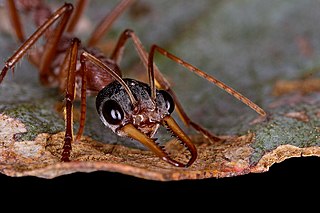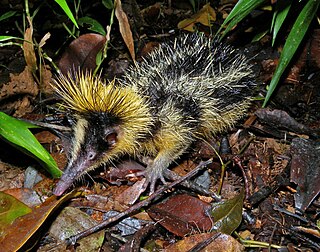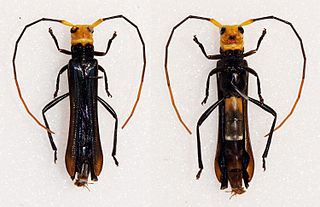
The great Indian bustard or Indian bustard is a bustard occurring on the Indian subcontinent. It is a large bird with a horizontal body and long bare legs, and is among the heaviest of the flying birds. Once common on the dry grasslands and shrubland in India, as few as 150 individuals were estimated to survive as of 2018, reduced from an estimated 250 individuals in 2011. It is critically endangered due to hunting and habitat loss. It is protected under the Indian Wild Life (Protection) Act, 1972.

The black-headed night monkey is a night monkey species from South America. It is found in Brazil, Bolivia and Peru. The A. nigriceps in Peru were notably inhabiting areas that were degraded, and often these areas were disturbed either by human activities or natural occurrences in the ecosystem. A black-headed night monkey is about the same size as a small squirrel. Black-headed night monkeys have small ears that are hidden by their fur. When they become adults they are about 750g and usually are about 14 months old. Black-headed night monkeys have three black stripes that meet on their forehead. These monkeys have white patches by their eyes, cheeks, and under their mouth. Their eyes are very large and brown.

The black-headed marmoset is a marmoset species endemic to Brazil. It inhabits humid tropical rainforest, mostly second growth and edge; the distribution is not exactly known but is thought to be Rio dos Marmelos in the north and east, Madeira River in the west and Ji-Paraná River in the south.

The black-crowned sparrow-lark is a species of lark in the family Alaudidae. It is found across northern Africa from Mauritania through the Middle East to north-western India. Its natural habitat is dry savanna.

The grey-throated babbler is a species of passerine bird in the Old World babbler family Timaliidae.

Myrmecia nigriceps, also known as the black-headed bull ant, is a species of ant endemic to Australia. A member of the genus Myrmecia in the subfamily Myrmeciinae, it was first described by Austrian entomologist Gustav Mayr in 1862. These ants are large, varying from 19 to 23 millimetres in length. However, colonies contain workers that are much smaller, usually half the size of normal workers. The queens are the largest while the males are the smallest, which can be easily identified due to their small mandibles.

Hemicentetes is a genus of tenrec with two species, present on the island of Madagascar.

Neonitocris is a genus of longhorn beetles of the subfamily Lamiinae, containing the following species:

The black-headed sugar ant, also known as the brown sugar ant, is a species of Formicinae ant endemic to Australia. Found throughout most states, the species is a member of the genus Camponotus, a cosmopolitan genus of ants commonly known as carpenter ants. It was formally described and named by British entomologist Frederick Smith in 1858. These ants are characterised by their black head, reddish-brown mesosoma and black gaster, which can change in colour.

Neonitocris princeps is a species of beetle in the family Cerambycidae. It was described by Karl Jordan in 1894, originally under the genus Nitocris. It has a wide distribution in Africa.
Neonitocris regina is a species of beetle in the family Cerambycidae. It was described by Karl Jordan in 1894.
Neonitocris gaboniensis is a species of beetle in the family Cerambycidae. It was described by Stephan von Breuning in 1956.
Neonitocris infrarufa is a species of beetle in the family Cerambycidae. It was described by Stephan von Breuning in 1956.
Neonitocris sibutensis is a species of beetle in the family Cerambycidae. It was described by Stephan von Breuning in 1956.
Neonitocris spiniscapus is a species of beetle in the family Cerambycidae. It was described by Stephan von Breuning in 1956.
Neonitocris calva is a species of beetle in the family Cerambycidae. It was described by James Thomson in 1868.
Neonitocris mangenoti is a species of beetle in the family Cerambycidae. It was described by Lepesme and Stephan von Breuning in 1953.
Neonitocris plicata is a species of beetle in the family Cerambycidae. It was described by Hintz in 1919.
Neonitocris rubriventris is a species of beetle in the family Cerambycidae. It was described by Hintz in 1919.

The black-capped paradise kingfisher or black-headed paradise kingfisher, is a bird in the tree kingfisher subfamily, Halcyoninae. It is native to several islands in the Bismarck Archipelago to the east of New Guinea. Like all paradise kingfishers, this bird has colourful plumage with a red bill and long distinctive tail streamers.









